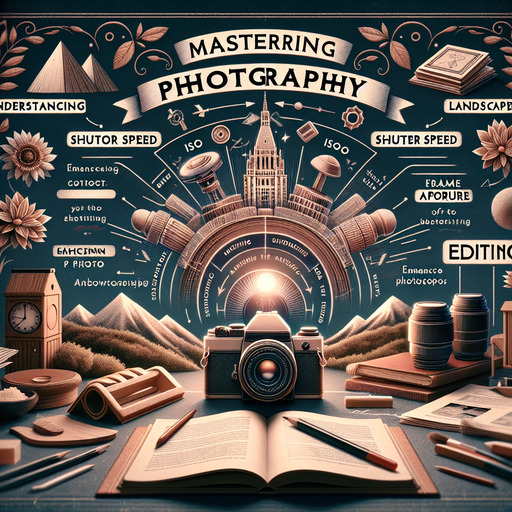
-
Table of Contents
- Mastering Photography: Tips and Techniques for Stunning Shots
- Understanding the Basics of Photography
- Exposure Triangle: Balancing ISO, Shutter Speed, and Aperture
- Composition: The Art of Framing Your Shot
- Advanced Photography Techniques
- Portrait Photography: Capturing the Essence of Your Subject
- Landscape Photography: Embracing the Beauty of Nature
- Editing: Enhancing Your Photos
- Basic Editing Techniques
- Advanced Editing Tools
- Choosing the Right Photography Gear
- Cameras and Lenses
- Accessories
- Conclusion
- Questions and Answers
Mastering Photography: Tips and Techniques for Stunning Shots
Photography is more than just capturing moments; it’s about telling stories through images. Whether you’re a budding photographer or a seasoned professional, understanding the nuances of photography can elevate your work to new heights. In this guide, we’ll explore essential photography tips, techniques, and insights to help you capture breathtaking images.
Understanding the Basics of Photography
Before diving into advanced techniques, it’s crucial to grasp the fundamentals of photography. These basics form the foundation upon which you can build your skills.
Exposure Triangle: Balancing ISO, Shutter Speed, and Aperture
The exposure triangle is a core concept in photography, involving the interplay between ISO, shutter speed, and aperture. Mastering this balance is key to achieving the desired exposure in your photos.
- ISO: Adjusts the camera’s sensitivity to light. A higher ISO is useful in low-light conditions but can introduce noise.
- Shutter Speed: Controls the duration the camera’s sensor is exposed to light. Faster speeds freeze motion, while slower speeds can create motion blur.
- Aperture: Determines the size of the lens opening. A wider aperture (lower f-stop) allows more light and creates a shallow depth of field.
Composition: The Art of Framing Your Shot
Composition is about arranging elements within your frame to create a visually appealing image. Techniques like the rule of thirds, leading lines, and symmetry can enhance your composition.
Advanced Photography Techniques
Once you’ve mastered the basics, it’s time to explore advanced techniques that can add depth and creativity to your photography.
Portrait Photography: Capturing the Essence of Your Subject
Portrait photography is about capturing the personality and mood of your subject. Here are some tips to enhance your portrait shots:
- Lighting: Use natural light or soft artificial lighting to highlight your subject’s features.
- Background: Choose a simple background to keep the focus on your subject.
- Posing: Guide your subject into natural poses to convey emotion and authenticity.
Landscape Photography: Embracing the Beauty of Nature
Landscape photography allows you to capture the grandeur of nature. Consider these tips for stunning landscape shots:
- Golden Hour: Shoot during the golden hour (shortly after sunrise or before sunset) for soft, warm lighting.
- Foreground Interest: Include elements in the foreground to add depth and context to your images.
- Use a Tripod: Stabilize your camera for sharp images, especially in low-light conditions.
Editing: Enhancing Your Photos
Post-processing is an essential part of modern photography. Editing can enhance your images and bring your creative vision to life.
Basic Editing Techniques
Start with basic adjustments like cropping, exposure correction, and color balance. These simple edits can significantly improve your photos.
Advanced Editing Tools
Explore advanced tools like layers, masks, and filters to add artistic effects and refine your images further.
Choosing the Right Photography Gear
Your choice of gear can impact the quality of your photos. While skill is paramount, having the right equipment can enhance your capabilities.
Cameras and Lenses
Invest in a camera and lenses that suit your photography style. For instance, a wide-angle lens is ideal for landscapes, while a prime lens is great for portraits.
Accessories
Consider accessories like tripods, filters, and external flashes to expand your creative possibilities.
Conclusion
Photography is a journey of continuous learning and exploration. By mastering the basics, experimenting with advanced techniques, and choosing the right gear, you can capture stunning images that tell compelling stories. Remember, practice and creativity are your best tools in this artistic endeavor.
For more in-depth information on photography techniques, visit Wikipedia’s Photography Page.
Questions and Answers
Q1: What is the best time of day for landscape photography?
A1: The golden hour, shortly after sunrise or before sunset, is ideal for landscape photography due to its soft, warm lighting.
Q2: How can I improve my portrait photography skills?
A2: Focus on lighting, choose a simple background, and guide your subject into natural poses to enhance your portrait photography.
Q3: What basic editing techniques should I start with?
A3: Begin with cropping, exposure correction, and color balance to make significant improvements to your photos.
If you’re interested in learning more about photography or our services, please contact us for more information.